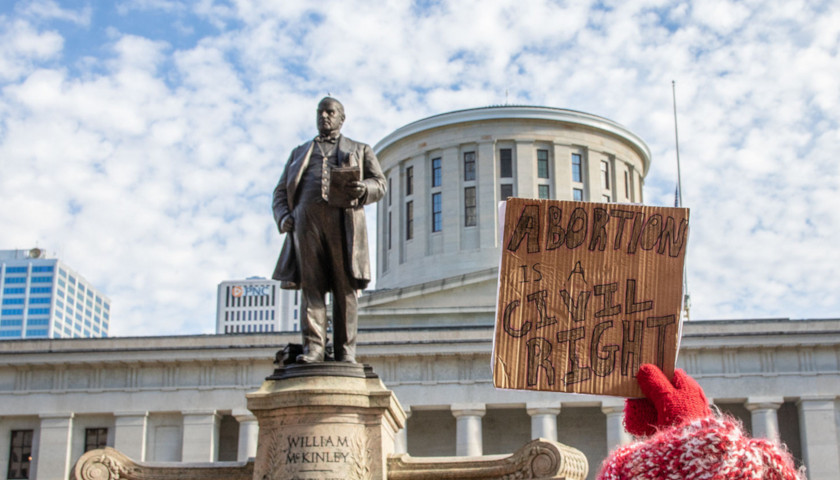The Ohio Senate’s decision to pass Senate Bill 23 (SB 23) on Wednesday has set the stage for a major political battle. While the bill still needs to clear both the Ohio House of Representatives and the Governor’s desk, advocacy groups from both sides are already preparing for a legal battle that could determine the fate of Roe v. Wade itself.
After clearing the Senate, SB 23 was formally introduced into the Ohio House of Representatives on Thursday. There are two very distinct aspects of the legislation: the law as it is written and the law as it will affect current legislation. The law, as written, seeks to limit abortions to before a heartbeat can be detected. While this is largely dependent on available technology, the range in which a fetal heartbeat can be detected is, generally, six to nine weeks. This would essentially limit all abortions in Ohio to before six weeks.
In an interview with The Ohio Star, Planned Parenthood of Greater Ohio Vice President of Government Affairs and Public Advocacy Lauren Blauvelt-Copelin stated that:
SB 23 is absolutely crafted to end access to safe legal abortion in Ohio. It’s a six week ban…It bans abortion before most people know they are pregnant, eliminating most decisions around abortion and medical care.”
According to statistics provided by the Center for Disease Control, in 2015, 34.2 percent of all abortions took place within the first six weeks of pregnancy. As the bill permits no exemptions for cases of rape or incest, almost 70 percent of all Ohio abortions in 2015 would be illegal under the new law.
There is no legal requirement for states to report abortion statistics and the numbers are provided only on a voluntary basis, therefore this only represents a sample of the complete picture. Statistically, a majority of women discover they are pregnant between weeks four to seven. Most pro-life groups don’t dispute these numbers and are why they believe it is essential to have early abortion limits. While the letter of the bill is controversial in it’s own right, it could have a major impact on the nation.
Roe v. Wade (1973), as written, established a framework for an abortion law that mainly revolves around one key metric: the trimester. The choice to have an abortion would be between a woman and her doctor in the first trimester; the first three months of the pregnancy. From the first trimester to “viability,” states would have the ability to regulate the procedure in order to protect the health of women and “potential life.” Once viability was established, abortion limits could be enacted by the states. However, when exactly viability begins was vague. It was generally agreed to be between the 24th and 28th weeks, but was left to the presiding doctor in each case. In the years that followed, and as medical science progressed, the question of viability became all the more complicated.
This led directly to Planned Parenthood v. Casey (1992), which ruled that “viability” was the ultimate barometer for abortion laws. The Court reaffirmed that women had a right to an abortion, though it also shifted from just the trimester limits to viability limits. That is, a woman has the right to a first-trimester abortion, but the states can regulate abortion after viability, now at 23-24 weeks, as well as before viability as long as it does not place an “undue burden” on a woman.
The heartbeat bill changes this dramatically.
While the detection of a heartbeat is a clear sign of life to many advocates, six to nine-week abortion limits are still unambiguously “pre-viability.” If upheld, this would reject the crux of both landmark abortion rulings and as a result, could potentially overturn Roe v. Wade. This bill would abolish “viability” as the standard and could lead to other such limitations. For many, this is precisely the point.
In an interview with The Ohio Star, Mike Gonidakis, president of the Ohio Right to Life, stated:
“I believe the passage of the heartbeat bill will lead to overturning of Roe v. Wade and is the best vehicle to overturn Roe.
In 2016 and 2018, then-Governor John Kasich vetoed the heartbeat bill in Ohio, despite passing other abortion limitations. He stated that he did so specifically because he saw it as a losing battle that would only cost Ohioans money in court fees. When Gonidakis was asked why this fight is happening now, when twice before Kasich refused it, he stated that one factor was a game-changer: “the Supreme Court.”
In 2011, the Ohio Right to Life, still led by Gonidakis, came out against the heartbeat bill, calling it the “right idea, wrong time.” Now, with new Supreme Court appointees made by President Donald Trump, he believes “now is the time to have that fight.”
“We’re ready to have that fight,” he said.
When asked how the current composition of the Supreme Court would affect the bill, Vice President Blauvelt-Copelin of Planned Parenthood stated that:
who sits on the Supreme Court absolutely has an impact on Roe v. Wade. We don’t know how they will make the decision but changing precedent is a huge deal.
Indeed, changing precedent is never done lightly and would still be a challenge even for a Supreme Court with a majority of Republican-appointed judges. Polling support for the measure remains delicate with 46 percent in favor and 47 percent opposed
Currently, there are almost a dozen other states also considering heartbeat bills that are at various stages of passage. It is likely that they will all be challenged in court and eventually consolidated into one case that the Supreme Court will likely hear. Contrary to popular belief, even if Roe v. Wade is overturned, this will not ban abortions, only move them to the state. Pro-life leaders like Gonadakis relish that challenge:
We are inspired that we are on the cusp of overturning Roe v. Wade. I cant wait for the day that we can close our doors because there are no more abortions in Ohio.
Before this can happen, however, the bill must pass the Ohio House and get Governor DeWine’s signature.
The Ohio House of Representatives is comprised of 99 members. Of these, 61 are Republican with 38 Democrats. To pass, 50 legislators must vote in its favor. Many of these legislators previously voted in favor of the heartbeat bill when it came before them in 2018 and 2016. In addition, 64 of the 99 members are currently endorsed by the Ohio Right to Life.
Plus, DeWine has said on multiple occasions that he will sign it once it reaches his desk. Despite these odds, Blauvelt-Copelin made it clear that pro-choice advocates would work to oppose it stating, “the time is now for Ohioans to call their State Representatives and Governor Mike DeWine to vote no.” When asked what the odds were that enough pro-life legislators would vote against the bill, Gonadakis made his prediction unambitious:
“Not a snowball’s chance in hell.”
One thing both groups do agree upon is that every legislative vote, for or against the measure, would be a vote for or against Roe v. Wade. Their decisions could directly impact the future of women’s rights and life rights in the entire country.
– – –
Andrew Shirley is a reporter at Battleground State News and The Ohio Star. Send tips to [email protected].
Photo “Abortion Protests” by Becker1999. CC BY 2.0.






I am prolife and I am happy that they are finding ways to stop abortion.
[…] recent passage of the Ohio heartbeat bill by the Ohio House of Representatives and its expected passage by the Senate and governor would […]